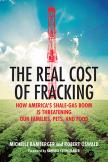Collateral Damage
Like most of the developed world, America has made a Faustian bargain with fossil fuels. We have traded the immediate benefit of cheap, abundant energy for environmental costs that are generally borne elsewhere by others, now or in the future. In The Real Cost of Fracking, Michelle Bamberger and Robert Oswald—a veterinarian and a professor of molecular medicine at Cornell University, respectively—take a closer look into what some of those costs may be and who bears them.
As the authors explain clearly in the extensive appendix, fracking, or hydraulic fracturing, is a nonconventional means of fossil fuel extraction from shale formations. It combines horizontal drilling techniques with the high-pressure injection of water and chemicals to fracture rock formations and liberate natural gas and oil.
Though not without controversy, fracking has been hailed as a silver bullet for domestic fuel production. It reduces our dependency on foreign supplies, lowers fuel prices and makes America a major player on the world energy stage. Because the molecular structure of natural gas makes it a less carbon-intensive fuel per unit of energy than coal or oil, America’s shale gas boom has even been touted as a way to reduce global warming due to carbon pollution—although the methane leaks in the production process may cause equivalent problems in their own right.
Bamberger and Oswald make no claim to put forth an airtight scientific argument proving the destructive effects of fracking. Instead, they document in-depth personal interviews with several rural families living in close proximity to drilling sites. These heartbreaking anecdotes demonstrate strong (though not conclusive) correlations between the onset of drilling and the onset of a raft of health issues for the family members, their pets and their livestock.
Josie and Jeff Bidermann, for example, raise horses, boxers and bulldogs south of Pittsburgh. When drilling commenced on a neighbor’s property, their water well and spring dried up and their healthy, two-year-old stud boxer became ill and died shortly after drinking from a puddle of drilling wastewater spilled on the road at the end of their driveway.
The Bidermanns’ neighbors, Sarah Valdes and her children, began experiencing headaches, nosebleeds, rashes, fatigue and gastrointestinal upset after their well water quality became degraded; Mrs. Valdes’s 13-year-old son David became chronically ill and was tested as having higher arsenic levels than an industrial worker. Eventually Sarah vacated her home, which she had spent over a decade renovating and which was subsequently vandalized; she cannot sell it and struggles to pay both her mortgage and rent.
These and other stories share many similar themes. Health issues arise in people, pets and livestock shortly after shale gas drilling commences nearby. Drilling companies generally admit little or no responsibility or else pay settlements linked with gag orders. Affected homeowners can rarely prove their cases because predrilling tests were not conducted on their air and water, and most cannot afford necropsies on their affected animals. Shale gas drilling is exempt from U.S. Environmental Protection Agency regulation, and patchwork state laws vary widely in latitude and enforcement, leaving individual citizens little protection or recourse.
Bamberger and Oswald recognize that in our energy-hungry economy, shale gas drilling is here to stay. Having uncovered such strong links between fracking and health issues, however, they conclude their argument by calling for a version of the precautionary principle: as with new drugs, a reasonable burden of proof should largely be on the drilling companies to demonstrate the safety of their methods. Drilling companies should provide upfront disclosure about the proprietary chemicals used in the drilling and fracturing process and should finance thorough pre- and postdrilling tests of air and water quality. More research must be done on the health effects of fracking chemicals—in combination and in various concentrations.
Finally, however, the authors point out that even if drilling can be conducted with a greater degree of justice and protection for those living close to drilling sites, fracking, like all fossil fuel production, is not a long-term solution for our energy needs. Ultimately, our economy will have to make a transition to renewables, both because even the newly abundant shale gas is still in finite supply and because the carbon pollution from burning all these reserves will wreak havoc on our climate.
Bamberger and Oswald readily admit that their evidence, however compelling, is limited and anecdotal. Perhaps the vast majority of those living around fracking sites experience no harm whatsoever and simply enjoy the royalties they receive. It is impossible to judge because so few come forward to share their experiences. But even if the stories the authors relate represent a minority group, those hardships still beg for redress, and they still call into question the unambiguously rosy picture of fracking painted by the extraction industry.
The Real Cost of Fracking is hardly pleasant bedside reading, but it is well written, and, most important, it spurs a necessary public conversation about our country’s newfound love affair with hydraulic fracturing. As beneficiaries of cheaper gas, all of us must ask ourselves whether the hidden costs are worth it.
This article also appeared in print, under the headline “Collateral Damage,” in the February 23, 2015, issue.








